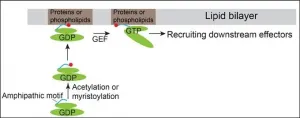A prognostic Alzheimer's disease blood test in the symptom-free stage
Memory deficit is a normal side effect of aging; at what point does memory loss become pathological?
2021-01-06
(Press-News.org) Using a blood test, a German-Dutch research team has predicted the risk of Alzheimer's disease in people who were clinically diagnosed as not having Alzheimer's disease but who perceived themselves as cognitively impaired (Subjective Cognitive Declined, SCD). The researchers analyzed blood samples from an SCD cohort supervised at the Alzheimer Center Amsterdam. Using a test developed at Ruhr-Universität Bochum (RUB) called the Immuno-Infrared Sensor, they identified all 22 subjects at study entry who developed Alzheimer's dementia, thus the clinical symptoms, within six years. The test also showed which subjects were at very low risk to develop Alzheimer's dementia within six years. The team describes the results in the journal Alzheimer's Research and Therapy, published online 24 December 2020.
For the study, the team led by biophysics Professor Klaus Gerwert and Julia Stockmann of the Bochum Research Center for Protein Diagnostics (Prodi) collaborated with RUB statistician Professor Nina Timmesfeld, Department of Medical Informatics, Biometry and Epidemiology, and researchers from the Amsterdam University Medical Centers, Location Vrije University (VUmc) led by Professor Charlotte Teunissen and Professor Philip Scheltens.
Sensor detects misfolded proteins in blood
The SCD cohort included 203 individuals. At study entry, blood samples were taken from all the participants and analyzed using the patented immuno-infrared sensor that detects misfolding of the amyloid-beta (Aβ) peptide, which is a biomarker for Alzheimer's disease. In addition, the subjects underwent extensive Alzheimer's disease diagnostic testing; at study entry, this did not provide a diagnosis of Alzheimer's disease in any of the subjects studied. The immuno-infrared sensor, on the other hand, detected misfolded Aβ peptides at study entry in all 22 subjects who developed the clinical disease in the following six years. In subjects who showed mild misfolding, it took on average longer (3.4 years) for conversion to clinical Alzheimer than in subjects with severe Aβ misfolding (2.2 years).
Together with statistician Nina Timmesfeld, the researchers predicted the risk of developing clinical Alzheimer's disease. According to the statistical model, SCD subjects with mild misfolding have an 11-fold higher risk and SCD subjects with severe misfolding have a 19-fold higher risk of developing clinical Alzheimer's in the following six years than subjects without misfolded Aβ peptide. "Misfolding of Aβ is therefore a very precise prognostic plasma biomarker," concludes Klaus Gerwert.
Combination of two biomarkers further improves prognosis
In addition, the team checked whether the combination of two different measurement methods in the plasma biomarker panel could further improve the prediction of disease risk. For this purpose, they combined the misfolding of all Aβ isoforms with a concentration decrease for Aβ42 as ratio to Aβ40 in plasma. The Amsterdam group measured Aβ concentrations using the new single-molecule array (SIMOA) technology. This increased the assay accuracy from an AUC (area under the ROC curve) of 0.94 to 0.99.
"We can now very accurately predict the risk of developing clinical Alzheimer's disease in the future, with a simple blood test on symptom-free individuals with subjective concerns," explains Klaus Gerwert. "However, we can just as confidently give the all-clear for SCD patients who have a very low probability of developing Alzheimer's disease in the next six years."
"Through the plasma biomarker panel, we can monitor disease progression over 14 years, beginning in the asymptomatic state with misfolding of Aβ and subsequent plaque deposition of Aβ42 in the brain associated with the first cognitive impairments," Julia Stockmann adds.
Hope for early-stage treatment
Such a blood test, which can detect the onset of Alzheimer's dementia even in the asymptomatic state, would be particularly useful if an active substance were available to treat the disease. In March 2021, the U.S. Food and Drug Administration will decide whether to approve the drug aducanumab. "Our results indicate that Alzheimer's drugs should be applied as early as possible in a non-clinical stage to improve therapy response," Klaus Gerwert said. The Bochum researcher is promoting the immuno-infrared sensor to be used in the selection of trial participants in the future to achieve a significantly better therapy response.
INFORMATION:
[Attachments] See images for this press release:

ELSE PRESS RELEASES FROM THIS DATE:
2021-01-06
Maybe you're like us. We're the folks who are on our smartphones almost all the time, even when we're with others. We know it annoys a lot of people, but we do it anyway. Why?
Researchers at the Norwegian University of Science and Technology (NTNU) have looked at why people in cafés pull out their phones, and how this affects café life. Three main reasons they identified are: to delay or pause a conversation (interaction suspension); to get out of a conversation (deliberately shielding interaction); and to share something with others (accessing shareables).
But what does that actually mean?
The smartphone is the world's most ubiquitous personal tech gizmo. ...
2021-01-06
Post-traumatic stress disorder, or PTSD, affects many people who are exposed to extreme situations, such as torture. Recent research suggests that chronic pain may make it more difficult to treat trauma.
"Trauma-focused therapy is effective for many patients with PTSD, enabling them to talk through the trauma they experienced", according to Iselin Solerød Dibaj, a psychologist at Oslo University Hospital.
However, not everyone benefits equally from this form of therapy.
"Torture victims who struggle with both chronic pain and PTSD unfortunately often reap less benefit from ordinary treatment," says Dibaj.
The Red Cross estimates that between 10 000 and 35 000 people with a refugee background who have come to Norway have experienced torture, reflecting ...
2021-01-06
The Earth is populated by an increasing number of people who demand more and more products, which is simply not viable in the long run. Our planet does not have unlimited resources. Emissions are harming the environment in various ways.
More companies thus need to switch to more sustainable production, sometimes due to pressure from consumers, but often resulting from new rules imposed by the authorities.
But this kind of change can't ever pay off - or can it?
A new study by a research group from the Norwegian University of Science and Technology (NTNU) has reviewed 100 articles on how sustainably oriented innovation affects companies' competitiveness.
"The ...
2021-01-06
All athletes want to be at the top of their game when they compete, but some resort to nefarious approaches to achieve peak muscle growth, speed and agility. Recent developments in gene editing technology could tempt athletes to change their DNA to get an edge. Now, researchers reporting in ACS' Analytical Chemistry demonstrate first steps toward detecting this type of doping both in human plasma and in live mice.
The gene editing method called CRISPR/Cas is a popular way for scientists to precisely change the DNA in many organisms, and it recently gained even more attention when key developers of the method were awarded the 2020 Nobel Prize in Chemistry. With this method, researchers add an RNA molecule and a protein into cells. The RNA molecule guides the protein to the appropriate ...
2021-01-06
Conductive ink is a great tool for printing flexible electronic circuits on surfaces. But these inks can be costly, they do not work on some materials, and devices to apply them can plug up. Now, scientists report in ACS Applied Electronic Materials that they have developed inexpensive conductive inks for clog-free ballpoint pens that can allow users to "write" circuits almost anywhere -- even on human skin.
Flexible electronics are widely used in applications such as biosensors, electronic skin and energy storage. Recent advances to produce such devices include pens ...
2021-01-06
Often considered the world's oddest mammal, Australia's beaver-like, duck-billed platypus exhibits an array of bizarre characteristics: it lays eggs instead of giving birth to live babies, sweats milk, has venomous spurs and is even equipped with 10 sex chromosomes. Now, an international team of researchers led by University of Copenhagen has conducted a unique mapping of the platypus genome and found answers regarding the origins of a few of its stranger features.
It lays eggs, but nurses, it is toothless, has a venomous spur, has webbed feet, fur that glows and has 10 sex chromosomes. Ever since Europeans discovered the platypus in Australia during ...
2021-01-06
Using copper foil, glass containers and a conventional household microwave oven, University of Wyoming researchers have demonstrated that pulverized coal powder can be converted into higher-value nano-graphite.
The discovery is another step forward in the effort to find alternative uses for Wyoming's Powder River Basin coal, at a time when demand for coal to generate electricity is declining due to concerns about climate change.
In a paper published in the journal Nano-Structures & Nano-Objects, the UW researchers report that they created an environment in a microwave oven to successfully convert raw coal powder into nano-graphite, which is ...
2021-01-06
Hoppy beers such as pale ales are becoming increasingly popular. One reason is their pleasant fruity aroma that partially stems from compounds called thiols. Brewers have been looking for an accurate way to track thiols in beer, but current methods typically are not sensitive enough or require use of potentially harmful substances. Now, researchers in ACS' Journal of Agricultural and Food Chemistry present an automated, solvent-less process to assess thiols at very low concentrations.
Thiols, along with other compounds such as terpenes and esters, contribute to the enjoyable odors in "hop-forward" beer styles. Although very small amounts ...
2021-01-06
Naturopathic medicine, or herbal medicine, is all the rage, especially among young people. But how much of this is supported by science?
Ginger is known to have anti-inflammatory and anti-oxidative effects, making it a popular herbal supplement to treat inflammatory diseases.
And according to a Michigan Medicine led END ...
2021-01-06
The small GTPases of the ADP-ribosylation factor (Arf) family are key initiators of various physiological processes including secretion, endocytosis, phagocytosis and signal transduction. Arf family proteins function to mediate recruitment of cytosolic effectors to specific subcellular compartments. This process facilitates Arf effectors to perform cargo recognition, lipid modification or other cellular functions. Blocking the activities of Arf family proteins inhibits secretion of important molecules from the cell and also inhibits cellular uptake of nutrients. Defects in Arfs or their regulatory proteins are related to various inherited diseases, including X-linked intellectual disability (XLID), Joubert syndrome, Bardet-Biedl syndrome and cilia dysfunction. Thus, studying molecular ...
LAST 30 PRESS RELEASES:
[Press-News.org] A prognostic Alzheimer's disease blood test in the symptom-free stage
Memory deficit is a normal side effect of aging; at what point does memory loss become pathological?



